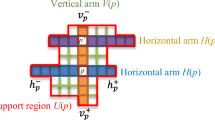Abstract
Common local stereo methods often compute integer-valued disparities at support windows. The implicit assumption of a constant disparity value in support windows generally does not produce accurate results on slanted surfaces. In this paper, we propose a global optimization method for reconstructing disparity maps. Our optimization strategy is an extension of Xu’s (ACM Trans Graph 30(6):1–12, 2011) image smoothing algorithm. The strategy is to develop a sparse gradients counting model of the disparity map, coupled with the priors of intensity edges of the reference image. Based on this model, the disparity optimization problem is then formulated as a constrained optimization objective function, which is finally solved via the half-quadratic splitting algorithm. Experimental results demonstrated that the proposed approach improves the quality of the disparity maps regarding slanted surfaces and local discontinuity preservation.







Similar content being viewed by others
References
Xu, L., Lu, C., Xu, Y., Jia, J.: Image smoothing via L0 gradient minimization. ACM Trans. Graph. 30(6), 1–12 (2011)
Miyazawa, K., Aoki, T.: A robot-based 3D body scanning system using passive stereo vision. In: International Conference on Image Processing, pages 305–308 (2008)
Tylecek, R., Sara, R.: Refinement of surface mesh for accurate multi-view reconstruction. Int. J. Virtual Real. 9(1), 45–54 (2010)
Jang, W.S., Ho, Y.S.: Efficient depth map generation with occlusion handling for various camera arrays. Signal Image Video Process. 8(2), 287–297 (2014)
Raghavendra, U., Makkithaya, K., Karunakar, A.K.: Anchor-diagonal-based shape adaptive local support region for efficient stereo matching. Signal Image Video Process. 1–9 (2013). doi:10.1007/s11760-013-0524-4
Ohta, Y., Kanade, T.: Stereo by intra- and inter- scanline search using dynamic programming. IEEE Trans. Pattern Anal. Mach. Intell. 7(2), 139–154 (1985)
Boykov, Y., Veksler, O., Zabih, R.: Fast approximate energy minimization via graph cuts. IEEE Trans. Pattern Anal. Mach. Intell. 23(11), 1222–1239 (2001)
Park, J., Kim, W., Lee, J.M.: Stereo matching using population-based MCMC. Int. J. Comput. Vis. 83, 195–209 (2009)
Miled, W., Pesquet, J.C., Parent, M.: A convex optimization approach for depth estimation under illumination variation. IEEE Trans. Image Process. 8(4), 813–830 (2009)
Brown, M.Z., Hager, G.D.: Advances in computational stereo. IEEE Trans. Pattern Anal. Mach. Intell. 25(8), 993–1008 (2003)
Han, D., Cho, J., Lee, B., Hwang, D.H.: Real-time object segmentation using disparity map of stereo matching. Appl. Math. Comput. 205, 770–777 (2008)
Yang, Q., Yang, R., Davis, J., Nister, D.: Spatial-depth super resolution for range images. In: Proceedings of the International Conference on Computer Vision Pattern Recognition, pp. 1–8 (2007)
Bleyer, M., Rhemann, C., Rother, C.: PatchMatch-stereo matching with slanted support windows. In: British Machine Vision Conference, pp.–11 (2011)
Scharstein, D., Szelinski, R.: Middleburry Stereo Vision Page. http://vision.edu/stereo/eval
Wang, L., Liao, M., Gong, M., Yang, R.: High-quality real-time stereo using adaptive cost aggregation and dynamic programming. In: International Symposium on 3D Data Processing, Visualization and Transmission, pp. 798–805 (2006)
Mukherjee, D., Wang, G., Wu, J.: Stereo matching algorithm based on curvelet decomposition and modified support weights. In: Proceedings of the IEEE Conference Acoustics Speech and Signal Processing, pp. 758–761 (2010)
Zhou, X., Boulanger, P.: Radiometric invariant stereo matching based on relative gradients. In: Proceedings of the IEEE Conference Image Processing, pp. 2989–2992 (2012)
Zhou, X., Boulanger, P.: New eye contact correction using radial basis function for wide baseline videoconference system. In: Pacific-Rim Conference on Multimedia, pp. 68–79 (2012)
Woodford, O., Torr, P., Reid, I., Fitzgibbon, A.: Global stereo reconstruction under second order smoothness priors. In: Proceedings of the International Conference Computer Vision Pattern Recognition, pp. 1–8 (2008)
Acknowledgments
This work was supported by the National Natural Science Foundation of China (No. 61263046, 61462065), Natural Science Foundation of Jiangxi Province (20122BAB201037).
Author information
Authors and Affiliations
Corresponding author
Rights and permissions
About this article
Cite this article
Miao, J., Chu, J. & Zhang, G. Disparity map optimization using sparse gradient measurement under intensity-edge constraints. SIViP 10, 161–169 (2016). https://doi.org/10.1007/s11760-014-0722-8
Received:
Revised:
Accepted:
Published:
Issue Date:
DOI: https://doi.org/10.1007/s11760-014-0722-8




